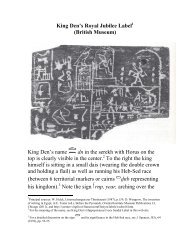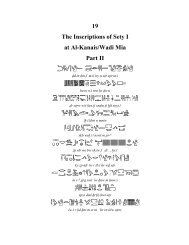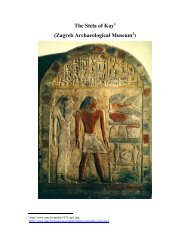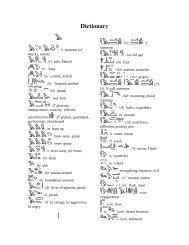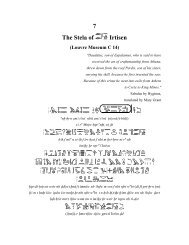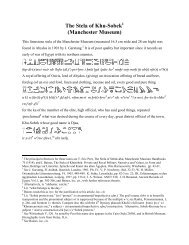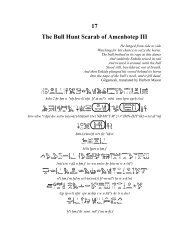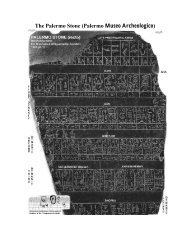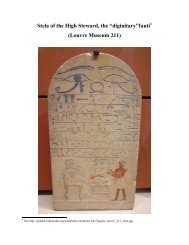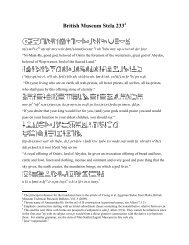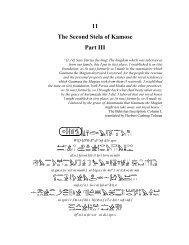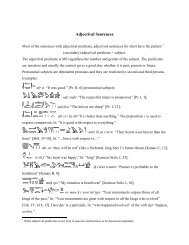The Stela of Min-Nakht - Middle Egyptian Grammar through Literature
The Stela of Min-Nakht - Middle Egyptian Grammar through Literature
The Stela of Min-Nakht - Middle Egyptian Grammar through Literature
Create successful ePaper yourself
Turn your PDF publications into a flip-book with our unique Google optimized e-Paper software.
<strong>The</strong> <strong>Stela</strong> <strong>of</strong> <strong>Min</strong>-<strong>Nakht</strong><br />
(Zagreb Archaeological Museum)<br />
i sS/zXAw 1 nb, Xr(i)-H(A)b nb, wAb nb, r(m)Tt 2 nbt, swat(i).sn 3 Hr wD pn<br />
mrr.tn 4 Hz 5 n.tn nTrw.tn, swDA.tn iAwt.tn n Xrdw/nni.tn mi Dd.tn 6<br />
Oh all scribes, all lector priests, all wab-priests, all mankind who shall pass by this stela!<br />
If you desire that your gods would favor you, (and) would pass on your functions to your<br />
children, you say as follows (lit. according as your saying):<br />
Htp-di-(n)swt wsir n kA n Xr(i)-H(A)b n mnw m ipw, 7 mnw-nxt, 8 mAa xrw<br />
A royal <strong>of</strong>fering <strong>of</strong> Osiris for the ka <strong>of</strong> the lector priest <strong>of</strong> <strong>Min</strong> from Akhmim, <strong>Min</strong>-<strong>Nakht</strong>, the<br />
justified.<br />
i.nD Hr.k mnw, i.nD Hr.k Hrw, i.nD Hr.k Hrw smsw,<br />
nD (i)t(i) 9 m Htp, pA, 10 aHa Hr qAs n hAy/stS, 11 pA, it 12 pHti, Dd nfrw<br />
1 <strong>The</strong> traditional transliteration <strong>of</strong> “scribe” is sS; there is evidence that it has been spelled as zXAw.<br />
2 As the attached feminine primary adjective nbt shows that this is the feminine rmTt “mankind” and not the<br />
masculine rmT with similar meaning.<br />
3 Prospective participle.<br />
4 <strong>The</strong> geminated ending shows that mrr.tn is an imperfective relative form used nonattributively. This is an<br />
emphatic construction to express and emphasize initial condition; see J. Allen, <strong>Middle</strong> <strong>Egyptian</strong> <strong>Grammar</strong>, 25.11.1.<br />
5 This (and the next) verb form is prospective/subjunctive sDm.f, Allen (19.9). Hz cannot be a noun or an infinitive<br />
used as a noun since nothing (such as the dative n.tn) can stand between the parts <strong>of</strong> a direct genitive such as Hz<br />
nTrw.tn “favor <strong>of</strong> your gods.” For similar grammar, see the 12 th Dynasty stela BMEA 233 (from the reign <strong>of</strong><br />
Amenemhat III) in the article <strong>of</strong> Young et al, <strong>Egyptian</strong> <strong>Stela</strong>e from Malta, British Museum Technical Research<br />
Bulletin, Vol. 3 (2009), pp. 23-30.<br />
6 As it is governed by the preposition mi the verb form here is infinitive with suffixed subject in a direct genitive<br />
construction; it cannot be a (nominal) relative form.<br />
7 Also known as Khent-<strong>Min</strong> “Shrine <strong>of</strong> <strong>Min</strong>,” the Greek Panopolis, capital <strong>of</strong> the ninth (Chemmite) nome <strong>of</strong> Upper<br />
Egypt, one <strong>of</strong> the main cult centers <strong>of</strong> the god <strong>Min</strong>.<br />
8 <strong>The</strong> name has a typical construction “X is victorious” with X being a god.
Hail to you, <strong>Min</strong>, in peace! Hail to you, Horus, in peace! Hail to you Horus the Elder!<br />
Guard the father in safety! Fly, rising up on the ladder <strong>of</strong> Seth! Fly! Seize power! Speak<br />
goodness!<br />
9 During the <strong>Middle</strong> Kingdom <strong>Min</strong> became syncretized with Horus as <strong>Min</strong>-Hor. Consequently, he was sometimes<br />
referred to as a son <strong>of</strong> Isis. By confusion, he was also worshipped as a consort <strong>of</strong> Isis, thereby as the father <strong>of</strong> Horus.<br />
10 <strong>The</strong> position <strong>of</strong> pA rules out the possibility that it is a demonstrative pronoun. A sensible alternative is the verb<br />
“fly” with the wing determinative missing. Note that the ideogram writing for “fly” appears in the Pyramid<br />
Texts, Utterance 302; see also the next footnote.<br />
11 Variant writing <strong>of</strong> “Seth” (or reference to Seth); see Wörterbuch II, 483. For the “ladder <strong>of</strong> Seth”<br />
see R. O. Faulkner, <strong>The</strong> Ancient <strong>Egyptian</strong> Pyramid Texts, Oxford (1969), Utterance 478, p. 165. This passage has<br />
several possible translations, e.g. following Utterance 478: “Fly! Stand up on the ladder <strong>of</strong> Seth! Here, interpreting<br />
the second pA one can follow the regular practice that a demonstrative pronoun follows a god’s name.<br />
12 <strong>The</strong> regular imperative <strong>of</strong> the 3ae-inf. verb iti “seize, take control” is used here, not m.



